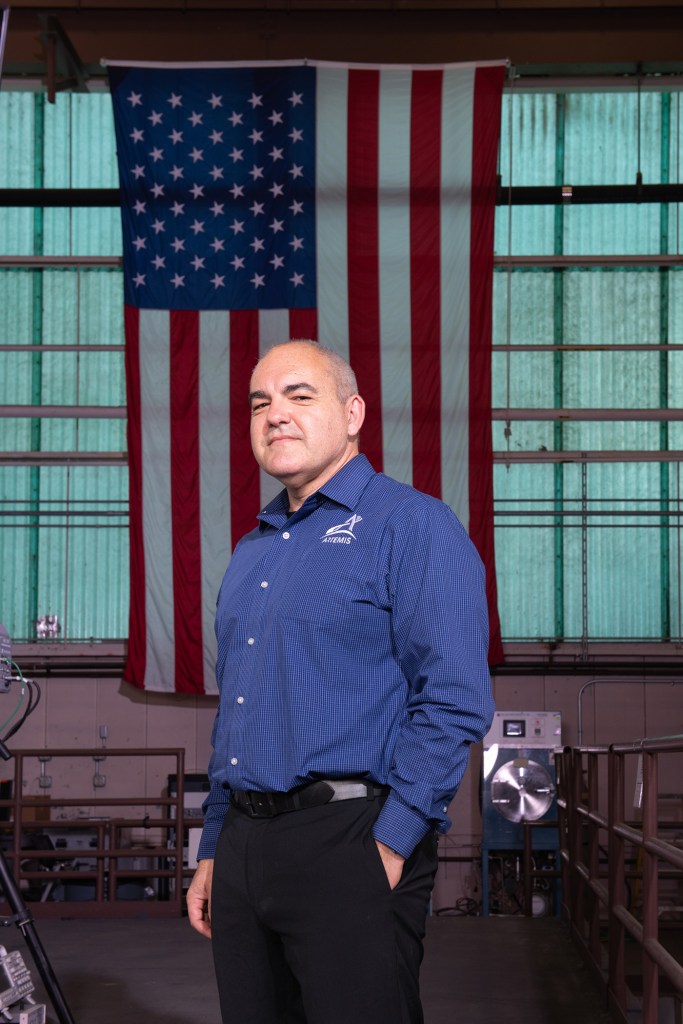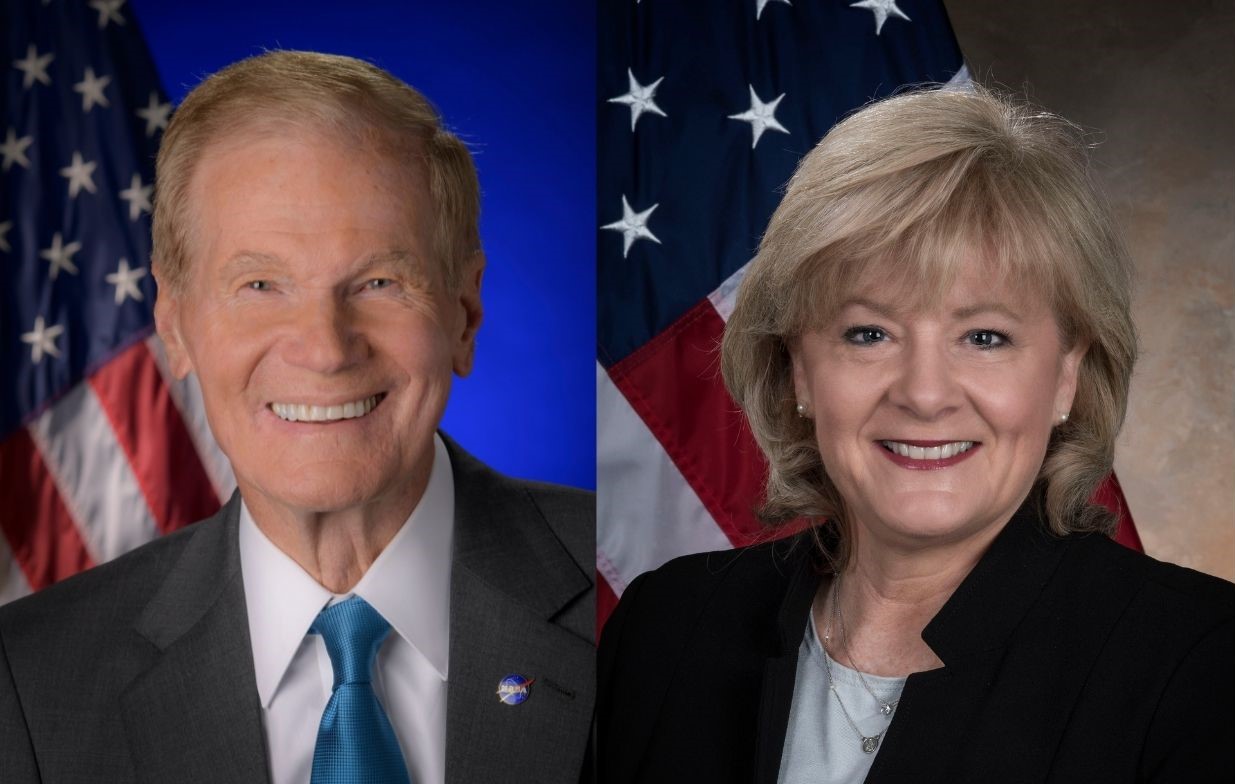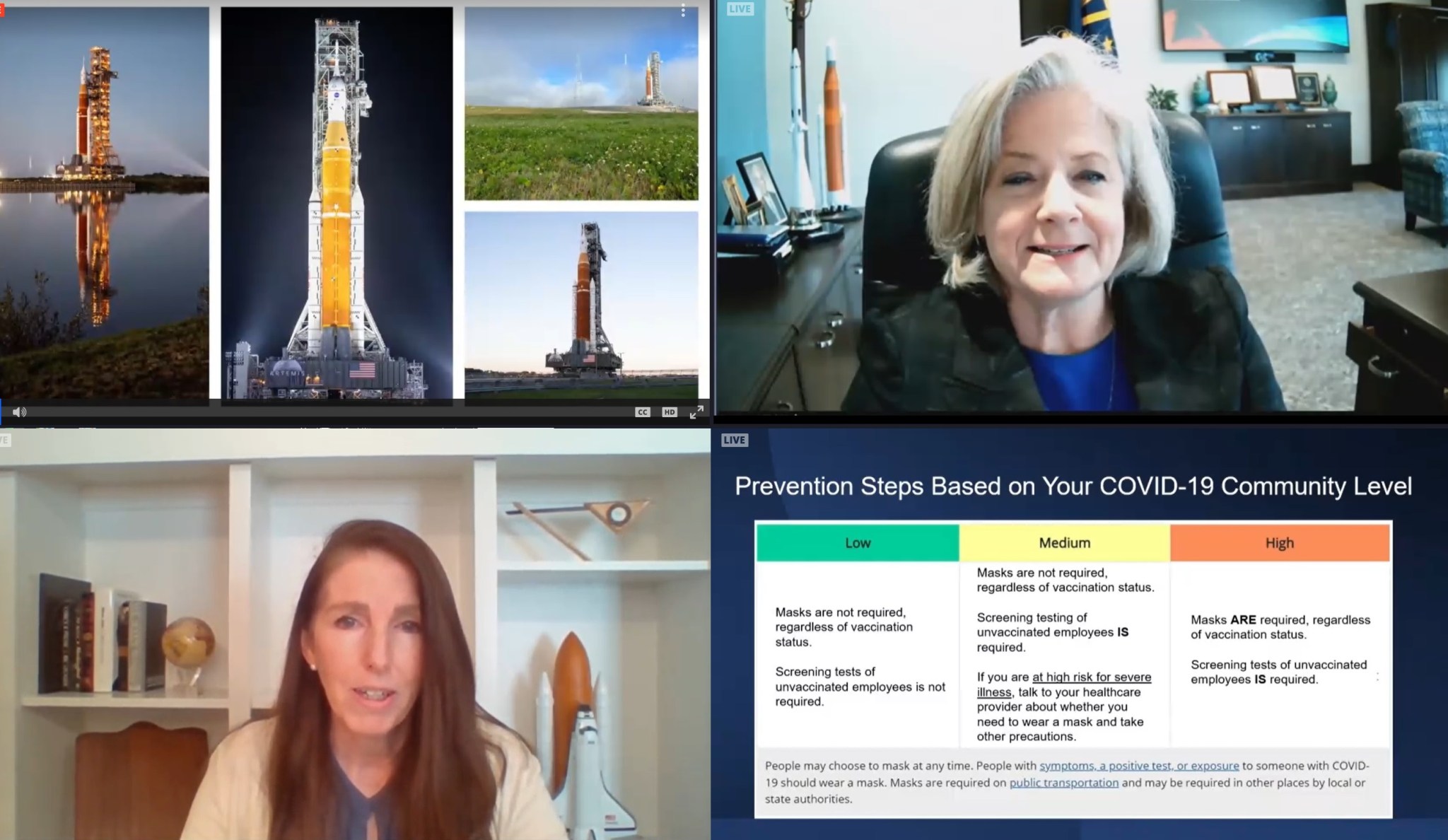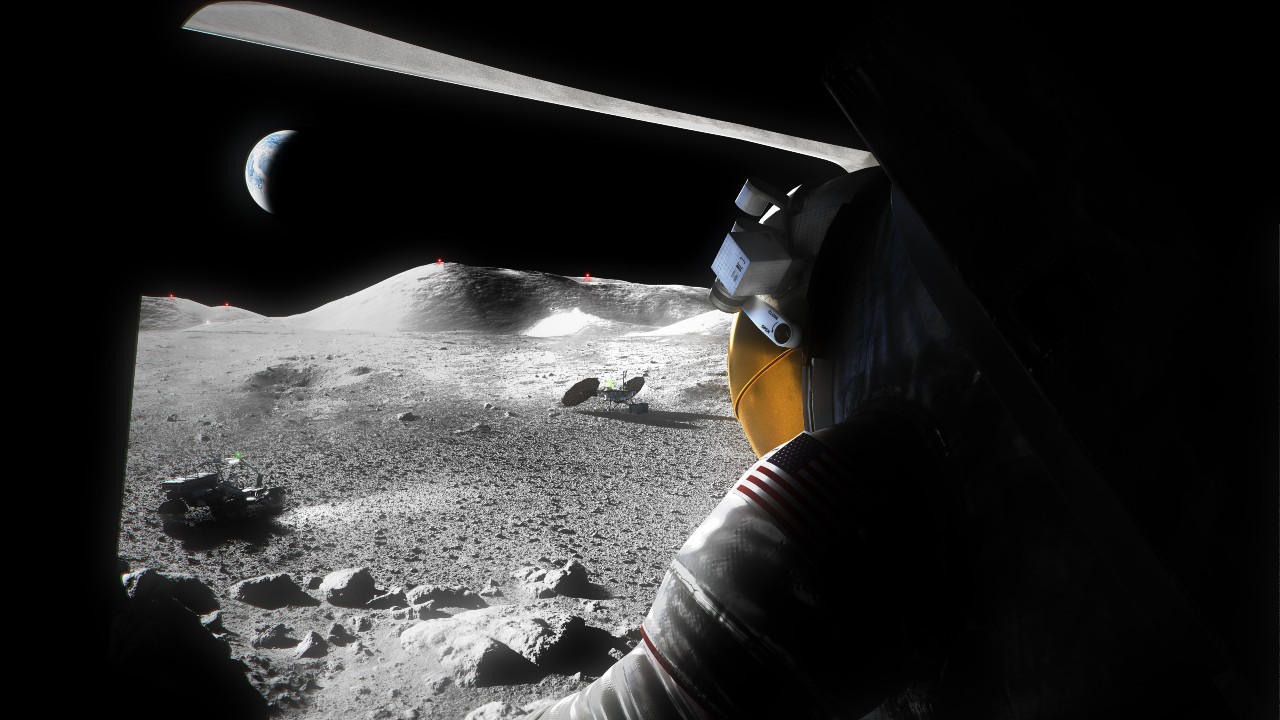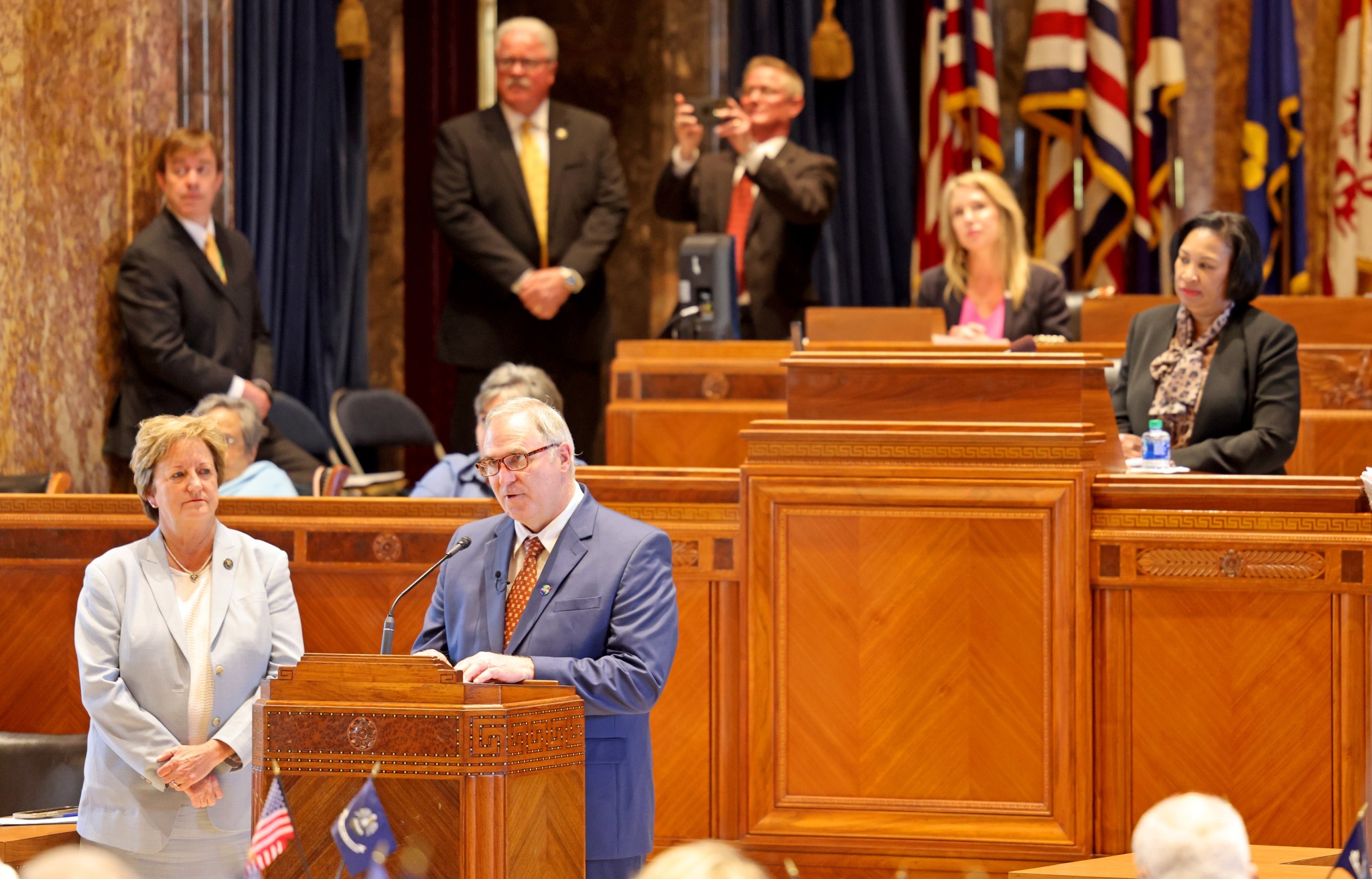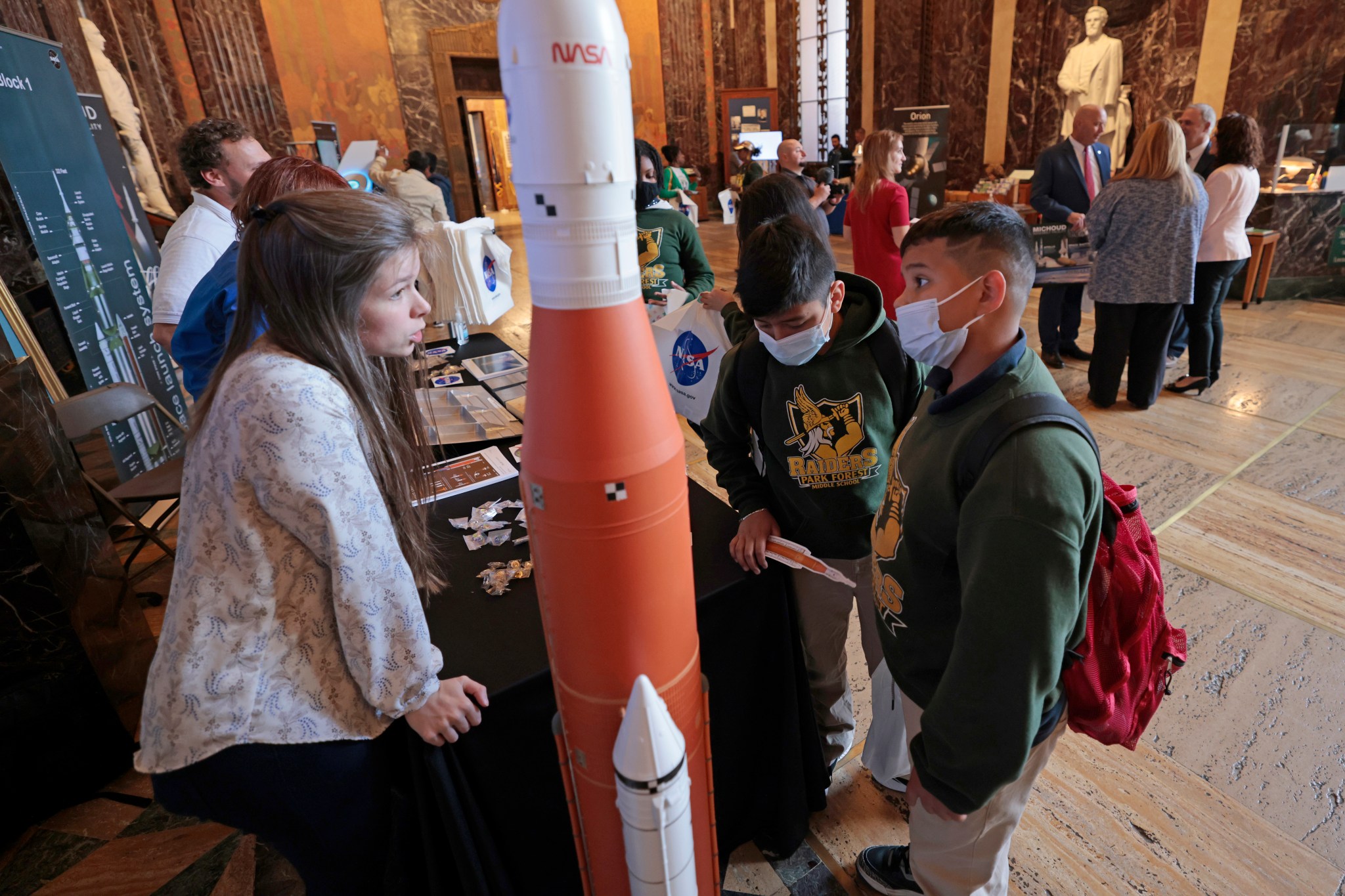NASA Readies Rocket for Artemis I Wet Dress Rehearsal
From April 1-3, engineers will conduct the final test, known as the wet dress rehearsal, of the Space Launch System (SLS) rocket, Orion spacecraft, and Exploration Ground Systems before the Artemis I launch at Launch Pad 39B at NASA’s Kennedy Space Center. The rehearsal will run the Artemis I launch team through operations to load propellant into the rocket’s tanks, conduct a full launch countdown, demonstrate the ability to recycle the countdown clock, and also drain the tanks to give them an opportunity to practice the timelines and procedures they will use for launch.
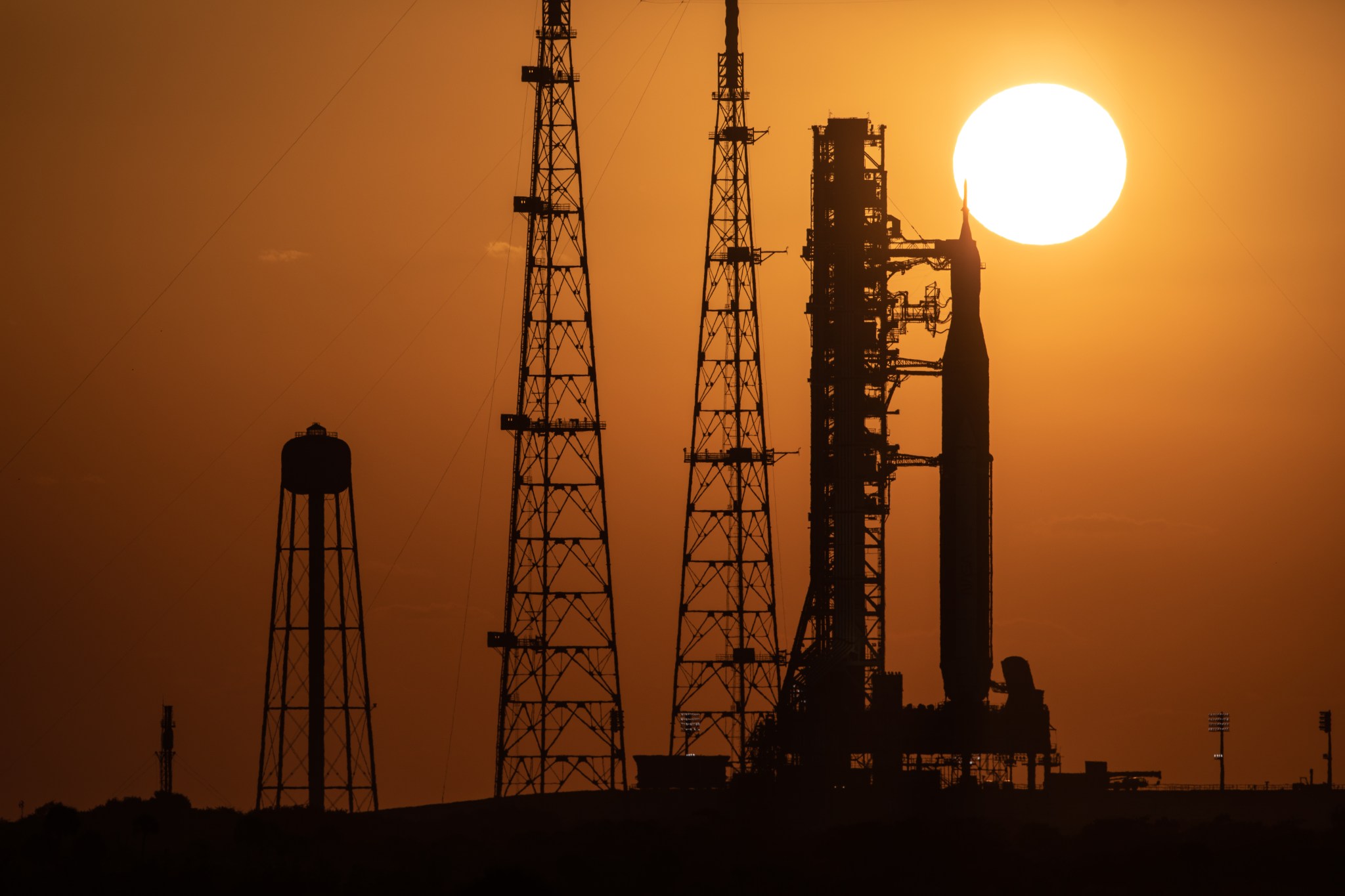
Teams will start by activating the facilities needed for launch and formally beginning the countdown sequence. Teams will staff the Launch Control Center at Kennedy and connect with staff in the Mission Control Center at NASA’s Johnson Space Center, the Space Force Eastern Range, and the SLS Engineering Support Center at the agency’s Marshall Space Flight Center. Launch controllers will power on different rocket and spacecraft systems, along with ground support equipment.
Teams will then load more than 700,000 gallons of cryogenic, or super cold, propellants including liquid hydrogen and liquid oxygen into the rocket at the launch pad on the mobile launcher, according to the detailed timeline they will use on the actual launch day. They will practice every phase of the countdown, including weather briefings, preplanned holds in the countdown, conditioning and replenishing the propellants as needed, and validation checks.
During the wet dress rehearsal, once launch controllers reach the point just before the rocket’s RS-25 engines will ignite on launch day, they will recycle back to the T-10 minute point, and then resume the countdown once more after a hold. The team will then deliberately halt the countdown at about 10 seconds before the simulated liftoff to demonstrate stopping a launch and draining the propellants from the rocket. Sometimes called a “scrub,” launch controllers may decide not to proceed with launch if a technical or weather issue arises during or prior to the countdown, so demonstrating the ability to remove propellants will ensure teams are prepared for various launch day scenarios.
Several days after the wet dress rehearsal, the integrated rocket and spacecraft will be rolled back to the Vehicle Assembly Building, where technicians will extend platforms to reestablish access to several parts of the rocket and spacecraft. They will remove sensors specifically used for monitoring during the wet dress rehearsal, charge Orion and other system batteries, stow late-load cargo into Orion, and run final checkouts on several elements, among other tasks. Orion and SLS will roll to the launch pad for a final time about a week before launch.
NASA will review data from the rehearsal before setting a specific target launch date for Artemis I. The first in a series of increasingly complex missions, Artemis I will provide a foundation for human deep space exploration and demonstrate NASA’s commitment and capability to extend human existence to the Moon and beyond prior to the first flight with crew on Artemis II.
NASA will provide live video of the rocket on the pad, without audio or commentary, beginning at 11 a.m. CDT on April 1, on the Kennedy Newsroom YouTube channel through the duration of the test. Real-time operations updates will be posted on the Artemis blog and social accounts.
Marshall manages the SLS Program. Marshall teams designed, developed, built, and tested hardware for the rocket.
NASA Administrator Bill Nelson, Marshall Director Jody Singer Address Proposed FY2023 Agency Budget
President Joe Biden’s proposed fiscal year NASA 2023 budget, released March 28, calls for $25.97 billion for the agency. It marks an 8% increase for the overall enacted NASA budget as compared to 2022 and the largest funding request for science in the agency’s history.
“Greater than a number, statistic, or fact is what the president’s budget request represents,” NASA Administrator Bill Nelson said. “This budget reflects the Biden-Harris Administration’s confidence in the extraordinary workforce that makes NASA the best place to work in the federal government. It’s an investment in the businesses and universities that partner with NASA in all 50 states and the good-paying jobs they are creating. It’s a signal of support for our missions in a new era of exploration and discovery.”
Comprehensive information about the proposed budget is available here. The request included $4.4 billion for NASA’s Marshall Space Flight Center for fiscal year 2023.
“This request demonstrates the president’s commitment to NASA and the people across the agency,” Marshall Director Jody Singer said. “Marshall is an asset to NASA and our nation. We make America’s space program stronger with our support to the International Space Station, the Space Launch System and upcoming Artemis I launch, the Imaging X-Ray Polarimetry Explorer, and the Human Landing System. Our important work continues in climate science and weather prediction, nuclear propulsion and in-space cryogenic storage, support of the Commercial Crew Program, advanced life support systems and habitat development, and progress on advanced space transportation systems like the Mars Ascent Vehicle.”
At NASA, the budget would:
Enable missions on and around the Moon through Artemis while preparing for Mars exploration. The budget provides $7.6 billion for deep space exploration. Through Artemis missions, NASA will land the first woman and person of color on the lunar surface, deepen the United States’ scientific understanding of the Moon, and test technologies that will prepare for human exploration of Mars.
Allow NASA to support and enhance lunar missions. The budget’s $4.7 billion for Common Exploration Systems Development to support lunar missions includes funding for the Orion spacecraft and Space Launch System (SLS). The budget’s $1.5 billion for astronaut Moon landers will enable NASA to increase competition in the development of the final mode of transportation needed to take astronauts to the lunar surface.
Increase NASA’s Earth science funding for climate and weather monitoring and measurement. The budget’s $2.4 billion for Earth-observing satellites and related research will enhance NASA’s ability to improve the world’s understanding of climate change.
Help NASA support commercial space activities. The budget’s $1.4 billion for space technology research and development will support new technologies to help the U.S. commercial space industry grow, enhance mission capabilities, create good-paying jobs, and reduce costs.
Maintain U.S. leadership in aircraft development and improve aviation to deliver benefits to the public. The budget would provide $970 million for aeronautics research. This includes $500 million to reduce aviation’s climate impact through efforts including a Sustainable Flight National Partnership to develop a next-generation passenger aircraft.
Allow NASA to continue building productive, strategic education collaborations. With $150 million for the Office of STEM Engagement for education and engagement activities, this budget would allow NASA to enhance its support for educational activities, including those that focus on historically underserved communities.
Marshall Leaders Discuss Return to Work Updates, Artemis I rollout, at Town Hall
NASA’s Marshall Space Flight Center leadership held a virtual town hall March 24. Marshall Director Jody Singer, upper right, and Associate Director Rae Ann Meyer, lower left, spoke at length about the successful launchpad rollout of the Space Launch System on March 18 and other mission successes, provided updates on future of work protocols, and answered team members’ questions. “There is nothing like seeing the SLS and Orion rolling out to the pad,” Singer said. “I can’t imagine the pride, the energy, the whole world watching as we make history in getting America back the ability to launch to the Moon.” Turning to COVID-19 updates, Meyer announced that NASA’s Michoud Assembly Facility was cleared to enter Stage 1 operations March 28 – enabling up to 75% of the Michoud workforce to return to site – and Marshall will step down to Stage 1 on April 4. Masks are no longer required, though Meyer stressed the policy could change if circumstances warrant. NASA employees and their supervisors are encouraged to complete return-to-work agreements by May 15, denoting each worker’s schedule for hybrid office and telework duties. Meyer said. “Life has thrown us for a loop,” Meyer said, “but Marshall has thrived due to your dedication to the mission.” She encouraged team members to visit the Future of Work page on Inside Marshall and the Safer Federal Workforce website for the latest updates to health and safety protocols, site access and travel guidelines, and more. (NASA)
NASA Provides Update to Astronaut Moon Lander Plans Under Artemis
As NASA makes strides to return humans to the lunar surface under Artemis, the agency announced plans March 23 to create additional opportunities for commercial companies to develop an astronaut Moon lander.
Under this new approach, NASA is asking American companies to propose lander concepts capable of ferrying astronauts between lunar orbit and the lunar surface for missions beyond Artemis III, which will land the first astronauts on the Moon in more than 50 years.
Built and operated according to NASA’s long-term requirements at the Moon, new landers will have the capability to dock to a lunar orbiting space station known as Gateway, increase crew capacity, and transport more science and technology to the surface.
“Under Artemis, NASA will carry out a series of groundbreaking missions on and around the Moon to prepare for the next giant leap for humanity: a crewed mission to Mars,” NASA Administrator Bill Nelson said. “Competition is critical to our success on the lunar surface and beyond, ensuring we have the capability to carry out a cadence of missions over the next decade. Thank you to the Biden Administration and Congress for their support of this new astronaut lander opportunity, which will ultimately strengthen and increase flexibility for Artemis.”
NASA’s plans call for long-term lunar exploration and include landing the first woman and first person of color on the Moon as part of future Artemis missions. The agency is pursuing two parallel paths for continuing lunar lander development and demonstration, one that calls for additional work under an existing contract with SpaceX, and another open to all other U.S. companies to provide a new landing demonstration mission from lunar orbit to the surface of the Moon.
In April 2021, NASA selected SpaceX as its partner to land the next American astronauts on the lunar surface. That demonstration mission is targeted for no earlier than April 2025. Exercising an option under the original award, NASA now is asking SpaceX to transform the company’s proposed human landing system into a spacecraft that meets the agency’s requirements for recurring services for a second demonstration mission. Pursuing more development work under the original contract maximizes NASA’s investment and partnership with SpaceX.
To bring a second entrant to market for the development of a lunar lander in parallel with SpaceX, NASA will issue a draft solicitation in the coming weeks. This upcoming activity will lay out requirements for a future development and demonstration lunar landing capability to take astronauts between orbit and the surface of the Moon. This effort is meant to maximize NASA’s support for competition and provides redundancy in services to help ensure NASA’s ability to transport astronauts to the lunar surface.
This upcoming second contract award, known as the Sustaining Lunar Development contract, combined with the second option under SpaceX’s original landing award, will pave the way to future recurring lunar transportation services for astronauts at the Moon.
“This strategy expedites progress toward a long-term, sustaining lander capability as early as the 2026 or 2027 timeframe,” said Lisa Watson-Morgan, program manager for the Human Landing System Program at NASA’s Marshall Space Flight Center. “We expect to have two companies safely carry astronauts in their landers to the surface of the Moon under NASA’s guidance before we ask for services, which could result in multiple experienced providers in the market.”
After the new draft solicitation is published, NASA will host a virtual industry day. Once comments and questions from the draft solicitation process have been reviewed, the agency plans by to issue the formal request for proposals this summer.
Astronaut Moon landers are a vital part of NASA’s deep space exploration plans, along with the Space Launch System rocket, Orion spacecraft, ground systems, and Gateway. NASA is committed to using a commercial astronaut lunar lander to carry the astronauts to the surface of the Moon, expanding exploration and preparing humanity for the next giant leap, human exploration of Mars.
Michoud Exhibits SLS, Orion, Artemis I Launch in Successful Return to NASA Day in Baton Rouge
By Heather Keller
Leadership and employees of NASA’s Michoud Assembly Facility assembled in the Louisiana State Capitol on March 23 for NASA Day in Baton Rouge, which ended a two-year hiatus of the event due to the COVID-19 pandemic.
Legislators, lobbyists, students, and visitors filtered through the Capitol rotunda as a team of exhibitors from Michoud, NASA’s Marshall Space Flight Center, and Lockheed Martin showcased the production of the Space Launch System core stage and the Orion crew module at the facility. Other exhibitors included the Office of Education from NASA’s Stennis Space Center, representatives from the Louisiana Board of Regent’s LaSTEM, and the Denham Venom robotics team from Denham Springs High School, which demonstrated NASA’s commitment to the future of space exploration through its science, technology, education, and math outreach efforts.
Visitors were able to speak with subject matter experts, view infographics and videos, have their photos taken with space-themed backgrounds, and engage exhibitors about ongoing efforts to further the Artemis mission at Michoud.
Both chambers of the state legislature recognized NASA, with special mention of the vital role Michoud plays in Artemis missions.
“A few months from now, the world’s most powerful rocket, the Space Launch System, will launch for the first time as part of the Artemis I mission,” Michoud Director Lonnie Dutreix told the Senate while accepting the recognition. “With the Artemis missions we will return to the Moon for the first time in 50 years and the path back to the Moon starts right here at Michoud Assembly Facility. SLS was built in our backyard by the people of Louisiana.”
Dutreix noted the economic impact Michoud brings not only to the state, but to the entire nation. “Beyond pursuing this generation’s space exploration dreams,” he said, “the NASA work at Michoud benefits 5,000 jobs in the nation and yields a total economic impact of $875 million nationally and includes $527 million just to the state of Louisiana.”
One notable absence from the event was Louisiana Gov. John Bel Edwards, who was assessing parts of the New Orleans area that suffered storm damage the night before the event. An EF3 tornado with 160 mph winds narrowly missed Michoud, and while the facility and flight hardware sustained no damage, the surrounding residential areas were ravaged. Both House Speaker Rep. Clay Schexnayder and Senate President Sen. Patrick Page Cortez acknowledged the devastation caused by the storm and held a moment of silence for Conner Lambert, a mechanical engineer with Syncom Space Services at Stennis, who resided in the New Orleans area and was fatally injured during the storm.
On behalf of Edwards, Sen. Sharon Hewitt presented Michoud with a proclamation declaring March 23, 2022, as NASA Day in Louisiana.
“Louisiana is leading NASA into deep space today and for generations to come as we build SLS for future Artemis mission,” Dutreix told the Senate. “I want to thank you for your continuing support of the center and our greater purpose of space exploration and science.”
Keller, a Manufacturing Technical Solutions employee, supports Marshall’s Office of Strategic Analysis & Communications.
Women Are Breaking the Bias at Marshall
Five team members from NASA’s Marshall Space Flight Center – Nina Creel, Tracey Washington, Denise Smithers, Rylee Cardon, and Lien Moore – discuss their roles at NASA and the challenges they’ve overcome as part of the Marshall Women’s History Month #BreakTheBias campaign. (NASA/Tyson Eason)
Barbara Askins’ Mission to Salvage Photo Data
Barbara Askins, a former Grissom High School physics teacher, joined the Solar Sciences Branch at NASA’s Marshall Space Flight Center in 1975 after receiving her master’s degree in chemistry from the University of Alabama in Huntsville. As part of her work, she developed a photographic enhancement process for salvaging data from underexposed solar and astronomy photos. She obtained a U.S. patent for this process, titled “Method of Obtaining Intensified Image from Developed Photographic Films and Plates” in July 1978. For more information on Women’s History Month at NASA, visit here. (NASA)

























